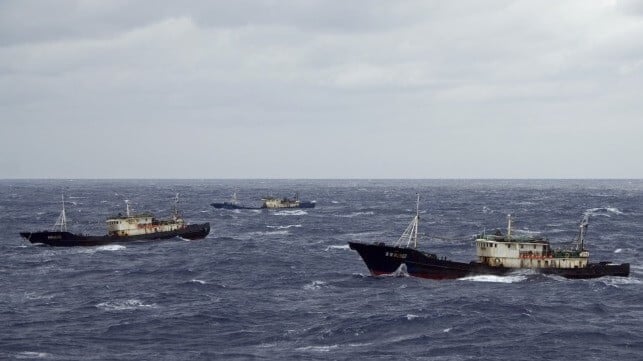Op-Ed: The Latest Science Supports Ending Harmful Fisheries Subsidies

Two decades ago, when the two of us were in primary school, the World Trade Organization (WTO) began negotiating an agreement to curb harmful fisheries subsidies—the payments that give industrial and small-scale fishers alike an incentive to increase fishing beyond sustainable levels. For many years, government leaders—relying on anecdotal evidence from their constituents—had a general sense that a WTO move to curb these subsidies would increase vulnerable fish stocks. Unfortunately, they had little evidence to back up this belief. But now they do. Thanks to technological advances over the past two decades, reliable scientific data shows that a WTO deal to end destructive fisheries subsidies could reduce overfishing and help threatened fish populations recover. Only a few weeks remain before the WTO’s 12th Ministerial Conference (MC12), where an agreement could be reached. It’s an opportunity that shouldn’t go to waste.
As policy experts and Millennial scientists, we and our colleagues have conducted research showing a deal’s potential impact on marine life. A bioeconomic model developed by the Environmental Markets Lab at the University of California, Santa Barbara, reveals that the most ambitious WTO-led subsidy reform—one that removes all harmful subsidies—could result in a 12.5 percent fish biomass increase by 2050. That means as much as 35 million metric tons of fish—and possibly more—in the sea, almost four times North America’s fish consumption in 2017 (the most recent year for which reliable data is available).
Although the current draft of the negotiating text is unlikely to get to this ambitious outcome, scientific advances, such as the SubsidyExplorer online tool, have allowed policymakers to compare the impact of the various proposals under consideration so they can shape a final WTO agreement that boosts fish populations to the greatest extent possible. This tool, which did not exist when negotiations began in 2001, relies on the latest data, including from organizations such as Global Fishing Watch, and provides long-term forecasts of each WTO policy reform scenario.
The SubsidyExplorer is one of several innovations that can help governments reduce subsidies and rebuild fish populations. Others include Global Fishing Watch’s database, which uses new satellite technology and machine learning to monitor fishing at sea. The University of British Columbia’s Fisheries Economics Research Unit has also built a global database of subsidy figures reported in government expenditure records and of estimates created by models. And advancements in open-source programming and software development have helped create interactive online data visualizations that, in turn, can help inform policymakers.
These innovations are important because they enable equitable access to data and greater transparency for the public, governments and the media alike. Data from better reporting has revealed that the sum of harmful subsidies given by governments continues to increase and that countries that supply their fishing fleets large amounts of harmful subsidies conduct the most distant-water fishing (DWF)—fishing that takes place outside of their own national jurisdiction in the exclusive economic zones (EEZs) of other countries, and even on the high seas.
New research also reveals that harmful subsidies enable large fishing nations to further their advantage on the water: China, the European Union, Japan, South Korea and Chinese Taipei are responsible for an estimated $1.5 billion in harmful subsidies that support their fishing in foreign countries’ EEZs. This estimate does not include the subsidies that enable their fishing on the high seas. However, the analysis reveals that these same five political entities spend at least $3.6 billion—and possibly more—to subsidize their high seas efforts. The newly developed DWF Subsidy Atlas interactive, another scientific resource designed to support the WTO subsidy negotiations, allows users to see the spatial distribution of DWF around the world and the magnitude of subsidies provided to support these efforts.
When negotiations started in 2001, only one global subsidy estimate had been released, and its figures were rudimentary and limited to the North Atlantic. But now, with the help of big data and technological advances, policymakers have evidence that ending harmful fisheries subsidies can lead to more fish in the sea. They can also see how much governments are spending to power their DWF fleets and where these fleets are fishing.
These comprehensive global and country-level estimates, combined with the clear research linking subsidies to overfishing, mean there’s no excuse to wait any longer for multilateral policy reform. In the few weeks left before MC12, WTO members need to be ambitious. While a robust subsidies deal is only one tool in the fight against overfishing, the principle of following the science in all ocean governance decisions—including at the WTO; national, regional fisheries management; and other levels—is absolutely critical to supporting sustainable fisheries moving forward. And the science shows that for fish stocks to begin to recover, governments must stop handing out harmful subsidies that encourage overfishing over wider areas of the ocean.
Policymakers have the data; now they need to use it. In 20 years, the two of us have grown from children who loved the environment to adults who are working to conserve it. The WTO cannot wait two more decades to stop funding overfishing: To ensure healthy fish stocks for future generations, the WTO must strike a deal to curb harmful fisheries subsidies now.
Reyna Gilbert is a principal associate with The Pew Charitable Trusts’ reducing harmful fisheries subsidies project and Kat Millage is a project researcher at University of California, Santa Barbara, where she provides data science and modeling support to many different ocean-related projects.
The opinions expressed herein are the author's and not necessarily those of The Maritime Executive.
